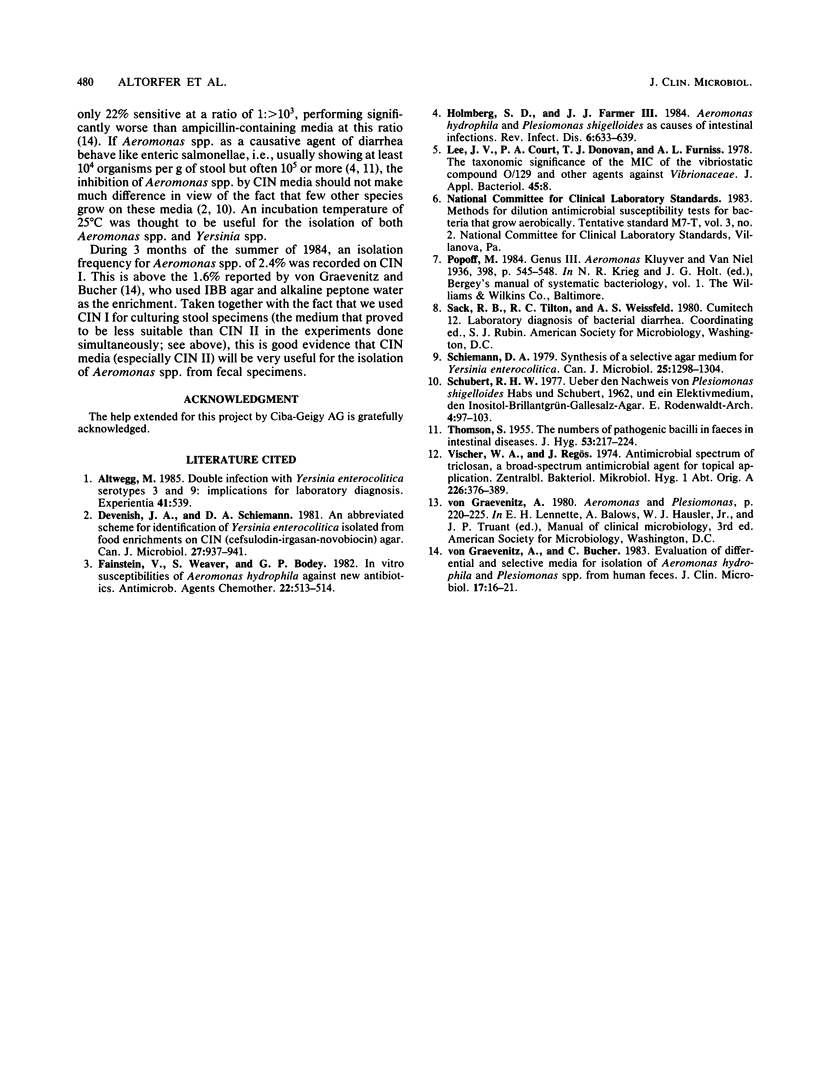Abstract
Twenty-eight strains of Aeromonas spp. were analyzed for their ability to grow on two different kinds of cefsulodin-Irgasan (triclosan; Ciba-Geigy AG, Basel, Switzerland)-novobiocin (CIN) agar containing 15 or 4 mg of cefsulodin per ml and on inositol-bile salts-brilliant green (IBB) agar. Relative to blood agar, 68% of the strains were inhibited by more than 2 logs (i.e., less than 1% growth) at 37 degrees C (39% at 25 degrees C) on CIN I (high cefsulodin concentration), 7% were inhibited at either temperature on CIN II (low cefsulodin concentration), 4% were inhibited on IBB agar at 37 degrees C, and none were inhibited on IBB agar at 25 degrees C. These results reflect the MICs of cefsulodin on CIN Base: the MIC for 50% of the strains was 8 mg/liter at 37 and 25 degrees C, and the MICs for 90% of the strains were 16 mg/liter at 37 degrees C and 64 mg/liter at 25 degrees C. The MICs of Irgasan and novobiocin were far beyond the concentrations used in CIN media. We argue that CIN agar containing 4 mg of cefsulodin per ml (CIN II) can be used for the simultaneous detection of Aeromonas spp. and Yersinia spp.
Full text
PDF


Selected References
These references are in PubMed. This may not be the complete list of references from this article.
- Devenish J. A., Schiemann D. A. An abbreviated scheme for identification of Yersinia enterocolitica isolated from food enrichments on CIN (cefsulodin-irgasan-novobiocin) agar. Can J Microbiol. 1981 Sep;27(9):937–941. doi: 10.1139/m81-146. [DOI] [PubMed] [Google Scholar]
- Fainstein V., Weaver S., Bodey G. P. In vitro susceptibilities of Aeromonas hydrophila against new antibiotics. Antimicrob Agents Chemother. 1982 Sep;22(3):513–514. doi: 10.1128/aac.22.3.513. [DOI] [PMC free article] [PubMed] [Google Scholar]
- Holmberg S. D., Farmer J. J., 3rd Aeromonas hydrophila and Plesiomonas shigelloides as causes of intestinal infections. Rev Infect Dis. 1984 Sep-Oct;6(5):633–639. doi: 10.1093/clinids/6.5.633. [DOI] [PubMed] [Google Scholar]
- Schiemann D. A. Synthesis of a selective agar medium for Yersinia enterocolitica. Can J Microbiol. 1979 Nov;25(11):1298–1304. doi: 10.1139/m79-205. [DOI] [PubMed] [Google Scholar]
- THOMSON S. The numbers of pathogenic bacilli in faeces in intestinal diseases. J Hyg (Lond) 1955 Jun;53(2):217–224. doi: 10.1017/s0022172400000681. [DOI] [PMC free article] [PubMed] [Google Scholar]
- Vischer W. A., Regös J. Antimicrobial spectrum of Triclosan, a broad-spectrum antimicrobial agent for topical application. Zentralbl Bakteriol Orig A. 1974 Mar;226(3):376–389. [PubMed] [Google Scholar]
- von Graevenitz A., Bucher C. Evaluation of differential and selective media for isolation of Aeromonas and Plesiomonas spp. from human feces. J Clin Microbiol. 1983 Jan;17(1):16–21. doi: 10.1128/jcm.17.1.16-21.1983. [DOI] [PMC free article] [PubMed] [Google Scholar]


